Calico网络的原理、组网方式与使用
目录
- 目录
- calico
- 名词解释
- 组网原理
- BGP与AS
- calico网络的部署
- calico系统结构
- calico中的概念
- node的报文处理过程
- calico系统的部署
- calico的使用
- 测试环境
- 参考
calico
calico是一个比较有趣的虚拟网络解决方案,完全利用路由规则实现动态组网,通过BGP协议通告路由。
calico的好处是endpoints组成的网络是单纯的三层网络,报文的流向完全通过路由规则控制,没有overlay等额外开销。
calico的endpoint可以漂移,并且实现了acl。
calico的缺点是路由的数目与容器数目相同,非常容易超过路由器、三层交换、甚至node的处理能力,从而限制了整个网络的扩张。
calico的每个node上会设置大量(海量)的iptables规则、路由,运维、排障难度大。
calico的原理决定了它不可能支持VPC,容器只能从calico设置的网段中获取ip。
calico目前的实现没有流量控制的功能,会出现少数容器抢占node多数带宽的情况。
calico的网络规模受到BGP网络规模的限制。
名词解释
endpoint: 接入到calico网络中的网卡称为endpoint
AS: 网络自治系统,通过BGP协议与其它AS网络交换路由信息
ibgp: AS内部的BGP Speaker,与同一个AS内部的ibgp、ebgp交换路由信息。
ebgp: AS边界的BGP Speaker,与同一个AS内部的ibgp、其它AS的ebgp交换路由信息。
workloadEndpoint: 虚拟机、容器使用的endpoint
hostEndpoints: 物理机(node)的地址
组网原理
calico组网的核心原理就是IP路由,每个容器或者虚拟机会分配一个workload-endpoint(wl)。
从nodeA上的容器A内访问nodeB上的容器B时:
+--------------------+ +--------------------+
| +------------+ | | +------------+ |
| | | | | | | |
| | ConA | | | | ConB | |
| | | | | | | |
| +-----+------+ | | +-----+------+ |
| |veth | | |veth |
| wl-A | | wl-B |
| | | | | |
+-------node-A-------+ +-------node-B-------+
| | | |
| | type1. in the same lan | |
| +-------------------------------+ |
| |
| type2. in different network |
| +-------------+ |
| | | |
+-------------+ Routers |-------------+
| |
+-------------+
从ConA中发送给ConB的报文被nodeA的wl-A接收,根据nodeA上的路由规则,经过各种iptables规则后,转发到nodeB。
如果nodeA和nodeB在同一个二层网段,下一条地址直接就是node-B,经过二层交换机即可到达。
如果nodeA和nodeB在不同的网段,报文被路由到下一跳,经过三层交换或路由器,一步步跳转到node-B。
核心问题是,nodeA怎样得知下一跳的地址?答案是node之间通过BGP协议交换路由信息。
每个node上运行一个软路由软件bird,并且被设置成BGP Speaker,与其它node通过BGP协议交换路由信息。
可以简单理解为,每一个node都会向其它node通知这样的信息:
我是X.X.X.X,某个IP或者网段在我这里,它们的下一跳地址是我。
通过这种方式每个node知晓了每个workload-endpoint的下一跳地址。
BGP与AS
BGP是路由器之间的通信协议,主要用于AS(Autonomous System,自治系统)之间的互联。
AS是一个自治的网络,拥有独立的交换机、路由器等,可以独立运转。
每个AS拥有一个全球统一分配的16位的ID号,64512到65535共1023个AS号码可以用于私有网络。
calico默认使用的AS号是64512,可以修改:
calicoctl config get asNumber //查看
calicoctl config set asNumber 64512 //设置
AS内部有多个BGP speaker,分为ibgp、ebgp,ebgp与其它AS中的ebgp建立BGP连接。
AS内部的BGP speaker通过BGP协议交换路由信息,最终每一个BGP speaker拥有整个AS的路由信息。
BGP speaker一般是网络中的物理路由器,可以形象的理解为:
calico将node改造成了一个软路由器(通过软路由软件bird)
node上的运行的虚拟机或者容器通过node与外部沟通
AS内部的BGP Speaker之间有两种互联方式:
Mesh: BGP Speaker之间全互联,网络成网状
RR: Router reflection模式,BGP Speaker连接到一个或多个中心BGP Speaker,网络成星状
BGP Speaker 全互联模式(node-to-node mesh)
全互联模式,就是一个BGP Speaker需要与其它所有的BGP Speaker建立bgp连接(形成一个bgp mesh)。
网络中bgp总连接数是按照O(n^2)增长的,有太多的BGP Speaker时,会消耗大量的连接。
calico默认使用全互联的方式,扩展性比较差,只能支持小规模集群:
say 50 nodes - although this limit is not set in stone and
Calico has been deployed with over 100 nodes in a full mesh topology
可以打开/关闭全互联模式:
calicoctl config set nodeTonodeMesh off
calicoctl config set nodeTonodeMesh on
BGP Speaker RR模式
RR模式,就是在网络中指定一个或多个BGP Speaker作为Router Reflection,RR与所有的BGP Speaker建立BGP连接。
每个BGP Speaker只需要与RR交换路由信息,就可以得到全网路由信息。
RR则必须与所有的BGP Speaker建立BGP连接,以保证能够得到全网路由信息。
在calico中可以通过Global Peer实现RR模式。
Global Peer是一个BGP Speaker,需要手动在calico中创建,所有的node都会与Global peer建立BGP连接。
A global BGP peer is a BGP agent that peers with every calico node in the network.
A typical use case for a global peer might be a mid-scale deployment where all of
the calico nodes are on the same L2 network and are each peering with the same Route
Reflector (or set of Route Reflectors).
关闭了全互联模式后,再将RR作为Global Peers添加到calico中,calico网络就切换到了RR模式,可以支撑容纳更多的node。
calico中也可以通过node Peer手动构建BGP Speaker(也就是node)之间的BGP连接。
node Peer就是手动创建的BGP Speaker,只有指定的node会与其建立连接。
A BGP peer can also be added at the node scope, meaning only a single specified node
will peer with it. BGP peer resources of this nature must specify a node to inform
calico which node this peer is targeting.
因此,可以为每一个node指定不同的BGP Peer,实现更精细的规划。
例如当集群规模进一步扩大的时候,可以使用AS Per Pack model:
每个机架是一个AS
node只与所在机架TOR交换机建立BGP连接
TOR交换机之间作为各自的ebgp全互联
calico网络的部署
calico网络对底层的网络的要求很少,只要求node之间能够通过IP联通。
Any technology that is capable of transporting IP packets can be used as the interconnect fabric in a Calico network.
在calico中,全网路由的数目和endpoints的数目一致,通过为node分配网段,可以减少路由数目,但不会改变数量级。
如果有1万个endpoints,那么就至少要有一台能够处理1万条路由的设备。
无论用哪种方式部署始终会有一台设备上存放着calico全网的路由。
当要部署calico网络的时候,第一步就是要确认,网络中处理能力最强的设备最多能设置多少条路由。
calico在Ethernet interconnect fabric中的部署方式
calico over an Ethernet interconnect fabric中介绍了在Ethernet interconnect fabric部署calico网络方案。在每个vlan中部署一套calico。
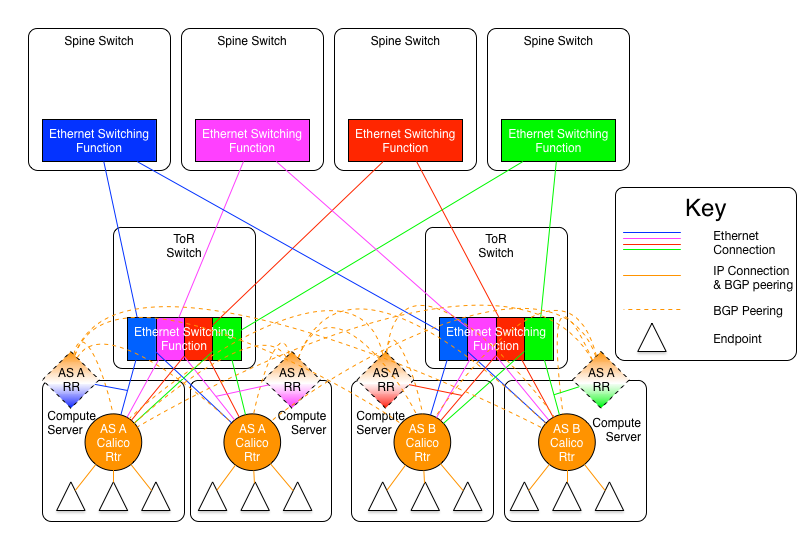
为了保证链路可靠,图中设计了四个并列的二层网,形成fabric。
每个node同时接入四个二层网络,对应拥有四个不同网段的IP。
在每个二层网络中,node与node之间用RR模式建立BGP通信链路:
一个node做为RR,其余的node连接到做为RR的node
整个网络中最终有四个RR,分别负责四个网络中的BGP
当从node上去访问另一个node上的endpoint的时候,会有四条下一跳为不同网段的等价路由。
根据ECMP协议,报文将会平均分配给这四个等价路由,提高了可靠性的同时增加了网络的吞吐能力。
calico在ip fabric中的部署方式
如果底层的网络是ip fabric的方式,三层网络是可靠的,只需要部署一套calico。
剩下的关键点就是怎样设计BGP网络,calico over ip fabrics中给出两种设计方式:
1. AS per rack: 每个rack(机架)组成一个AS,每个rack的TOR交换机与核心交换机组成一个AS
2. AS per server: 每个node做为一个AS,TOR交换机组成一个transit AS
这两种方式采用的是Use of BGP for routing in large-scale data centers中的建议。
AS per rack
1. 一个机架作为一个AS,分配一个AS号,node是ibgp,TOR交换机是ebgp
2. node只与TOR交换机建立BGP连接,TOR交换机与机架上的所有node建立BGP连接
3. 所有TOR交换机之间以node-to-node mesh方式建立BGP连接
TOR交换机之间可以是接入到同一个核心交换机二层可达的,也可以只是IP可达的。
TOR二层联通:
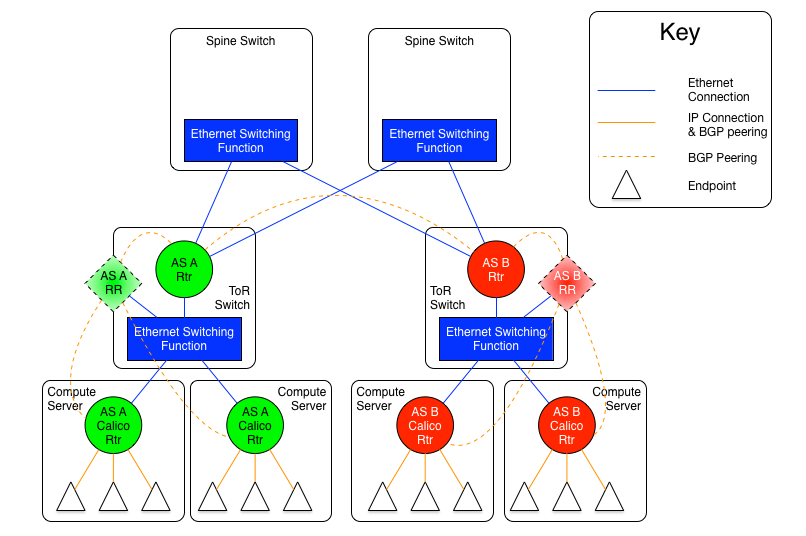
TOR三层联通:
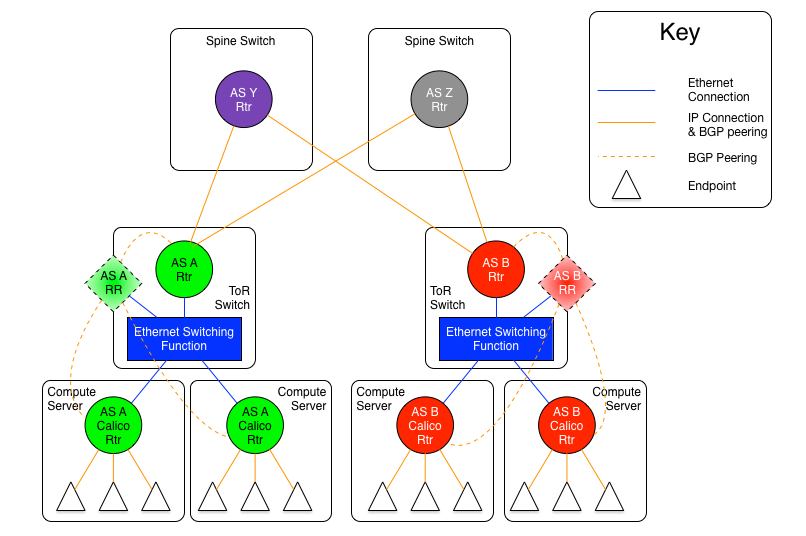
每个机架上node的数目是有限的,BGP压力转移到了TOR交换机。当机架数很多,TOR交换机组成BGP mesh压力会过大。
endpoints之间的通信过程:
EndpointA发出报文 --> nodeA找到了下一跳地址nodeB --> 报文送到TOR交换机A --> 报文送到核心交换机
|
v
EndpointB收到了报文 <-- nodeB收到了报文 <-- TOR交换机B收到了报文 <-- 核心交换机将报文送达TOR交换机B
AS per server
1. 每个TOR交换机占用一个AS
2. 每个node占用一个AS
3. node与TOR交换机交换BGP信息
3. 所有的TOR交换机组成BGP mesh,交换BGP信息
这种方式消耗了大量的AS,RFC 4893 - BGP Support for Four-octet AS Number Space中考虑将AS号增加到32位。
不是特别明白这种方式的好处在哪里。
TOR二层联通:
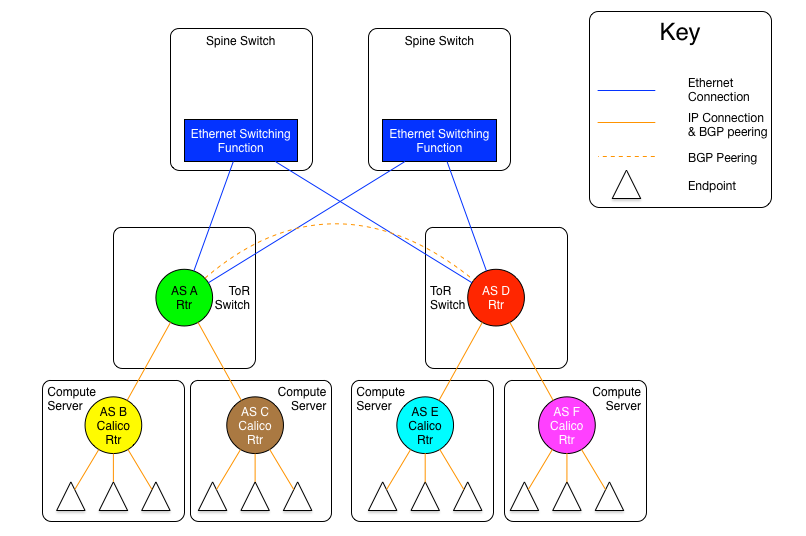
TOR三层联通:
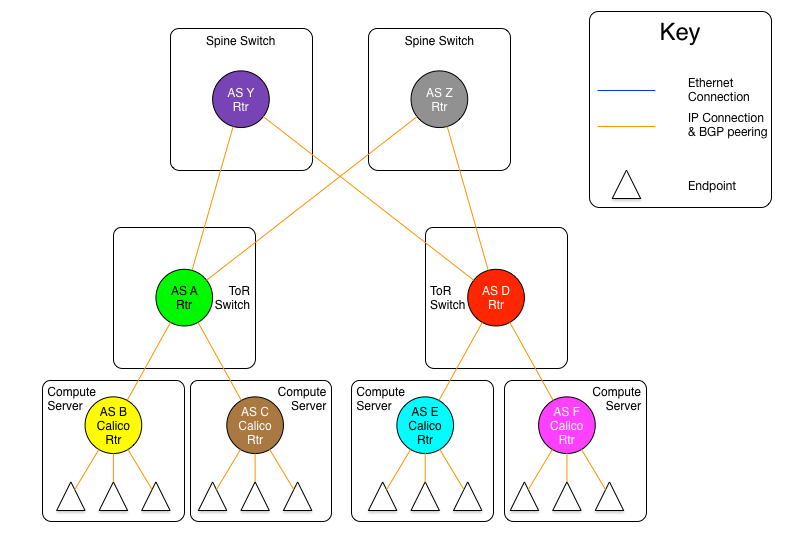
优化:“Downward Default model”减少需要记录的路由
Downward Default Model在上面的几种组网方式的基础上,优化了路由的管理。
在上面的三种方式中,每个node、每个TOR交换机、每个核心交换机都需要记录全网路由。
“Downward Default model”模式中:
1. 每个node向上(TOR)通告所有路由信息,而TOR向下(node)只通告一条默认路由
2. 每个TOR向上(核心交换机)通告所有路由,核心交换机向下(TOR)只通告一条默认路由
3. node只知晓本地的路由
4. TOR只知道接入到自己的所有node上的路由
5. 核心交换机知晓所有的路由
这种模式减少了TOR交换机和node上的路由数量,但缺点是,发送到无效IP的流量必须到达核心交换机以后,才能被确定为无效。
endpoints之间的通信过程:
EndpointA发出报文 --> nodeA默认路由到TOR交换机A --> TOR交换机A默认路由到核心交换机 --+
|
v
EndpointB收到了报文 <-- nodeB收到了报文 <-- TOR交换机B收到了报文 <-- 核心交换机找到了下一跳地址nodeB
calico系统结构
calico系统组成:
1. Felix, the primary calico agent that runs on each machine that hosts endpoints.
2. etcd, the data store.
3. BIRD, a BGP client that distributes routing information.
4. BGP Route Reflector (BIRD), an optional BGP route reflector for higher scale.
5. The Orchestrator plugin, orchestrator-specific code that tightly integrates calico into that orchestrator.
Felix负责管理设置node,
bird是一个开源的软路由,支持多种路由协议。
calico中的概念
calicoctl resource definitions介绍了每类资源的格式。
bgpPeer
apiVersion: v1
kind: bgpPeer
metadata:
scope: node
node: rack1-host1
peerIP: 192.168.1.1
spec:
asNumber: 63400
bgpPeer的scope可以是node、global。
ipPool
apiVersion: v1
kind: ipPool
metadata:
cidr: 10.1.0.0/16
spec:
ipip:
enabled: true
mode: cross-subnet
nat-outgoing: true
disabled: false
node
apiVersion: v1
kind: node
metadata:
name: node-hostname
spec:
bgp:
asNumber: 64512
ipv4Address: 10.244.0.1/24
ipv6Address: 2001:db8:85a3::8a2e:370:7334/120
policy
A Policy resource (policy) represents an ordered set of rules which are applied to a collection of endpoints which match a label selector.
Policy resources can be used to define network connectivity rules between groups of calico endpoints and host endpoints, and take precedence over Profile resources if any are defined.
apiVersion: v1
kind: policy
metadata:
name: allow-tcp-6379
spec:
selector: role == 'database'
ingress:
- action: allow
protocol: tcp
source:
selector: role == 'frontend'
destination:
ports:
- 6379
egress:
- action: allow
profile
A Profile resource (profile) represents a set of rules which are applied to the individual endpoints to which this profile has been assigned.
apiVersion: v1
kind: profile
metadata:
name: profile1
labels:
profile: profile1
spec:
ingress:
- action: deny
source:
net: 10.0.20.0/24
- action: allow
source:
selector: profile == 'profile1'
egress:
- action: allow
workloadEndpoint
A Workload Endpoint resource (workloadEndpoint) represents an interface connecting a calico networked container or VM to its host.
apiVersion: v1
kind: workloadEndpoint
metadata:
name: eth0
workload: default.frontend-5gs43
orchestrator: k8s
node: rack1-host1
labels:
app: frontend
calico/k8s_ns: default
spec:
interfaceName: cali0ef24ba
mac: ca:fe:1d:52:bb:e9
ipNetworks:
- 192.168.0.0/16
profiles:
- profile1
hostEndpoint
apiVersion: v1
kind: hostEndpoint
metadata:
name: eth0
node: myhost
labels:
type: production
spec:
interfaceName: eth0
expectedIPs:
- 192.168.0.1
- 192.168.0.2
profiles:
- profile1
- profile2
node的报文处理过程
报文处理过程中使用的标记位:
一共使用了3个标记位,0x7000000对应的标记位
0x1000000: 报文的处理动作,置1表示放行,默认0表示拒绝
0x2000000: 是否已经经过了policy规则检测,置1表示已经过
0x4000000: 报文来源,置1,表示来自host-endpoint
流入报文来源:
1. 以cali+命名的网卡收到的报文,这部分报文是node上的endpoint发出的
(k8s中,容器的内发出的所有报文都会发送到对应的cali网卡上)
(通过在容器内添加静态arp,将容器网关的IP映射到cali网卡的MAC上实现)
2. 其他网卡接收的报文,这部分报文是其它node发送或者在node本地发出的
流入的报文去向:
1. 访问本node的host endpoint,通过INPUT过程处理
2. 访问本node的workload endpoint,通过INPUT过程处理
3. 访问其它node的host endpoint,通过FORWARD过程处理。
4. 访问其它node的workload endpoint,通过FORWARD过程处理。
流入的报文在路由决策之前的处理过程相同的,路由决策之后,分别进入INPUT规则链和FORWARD链。
raw.PREROUTING -> mangle.PREROUTING -> nat.PREROUTING -> mangle.INPUT -> filter.INPUT
raw.PREROUTING -> mangle.PREROUTING -> nat.PREROUTING -> mangle.FORWARD -> filter.FORWARD -> mangle.POSTROUTING -> nat.POSTROUTING
这里分析的calico的版本比较老,和最新版中的规则有一些出入,但是原理相同。
新版本的calico的iptables规则可读性更好,可以直接阅读规则。
报文处理流程(全):
from-XXX: XXX发出的报文 tw: 简写,to wordkoad endpoint
to-XXX: 发送到XXX的报文 po: 简写,policy outbound
cali-: 前缀,calico的规则链 pi: 简写,policy inbound
wl: 简写,workload endpoint pro: 简写,profile outbound
fw: 简写,from workload endpoint pri: 简写,profile inbound
(receive pkt)
cali-PREOUTING@raw -> cali-from-host-endpoint@raw -> cali-PREROUTING@nat
| ^ |
| (-i cali+) | |
+--- (from workload endpoint) ----+ |
|
(dest may be container's floating ip) cali-fip-dnat@nat
|
(rotuer decision)
|
+--------------------------------------------+
| |
cali-INPUT@filter cali-FORWARD@filter
(-i cali+) | (-i cali+) | (-o cali+)
+----------------------------+ +------------+-------------+
| | | | |
cali-wl-to-host cali-from-host-endpoint | cali-from-host-endpoint |
@filter @filter | @filter |
| < END > | | |
| | cali-to-host-endpoint |
| | @filter |
| will return to nat's | < END > |
| cali-POSTROUTING | |
cali-from-wl-dispatch@filter <---------------------+ cali-to-wl-dispatch@filter
| \--------------+ |
+-----------------------+ | +----------------------+
| | | | |
cali-fw-cali0ef24b1 cali-fw-cali0ef24b2 | cali tw-cali03f24b1 cali-tw-cali03f24b2
@filter @filter | filter @filter
(-i cali0ef24b1) (-i cali0ef24b2) | (-o cali0ef24b1) (-o cali0ef24b2)
| | | | |
+-----------------------+ | +----------------------+
| | |
cali-po-[POLICY]@filter | cali-pi-[POLICY]@filter
| | |
cali-pro-[PROFILE]@filter | cali-pri-[PROFILE]@filter
| | |
< END > +------------> cali-POSTROUTING@nat
+---------->/ |
| cali-fip-snat@nat
| |
| cali-nat-outgoing@nat
| |
| (if dip is local: send to lookup)
+---------+--------+ (else: send to nic's qdisc)
| | < END >
cali-to-host-endpoint@filter |
| |
+------------------+
^ (-o cali+)
|
cali-OUTPUT@filter
^
(send pkt) |
(router descition) -> cali-OUTPUT@nat -> cali-fip-dnat@nat
node本地发出的报文,经过路由决策之后,直接进入raw,OUTPUT规则链:
raw.OUTPUT -> mangle.OUTPUT -> nat.OUTPUT -> filter.OUTPUT -> mangle.POSTROUTING -> nat.POSTROUTING
路由决策之前:流入node的报文的处理
进入raw表
PREROUTING@raw:
-A PREROUTING -m comment --comment "cali:6gwbT8clXdHdC1b1" -j cali-PREROUTING
cali-PREROUTING@RAW:
-A cali-PREROUTING -m comment --comment "cali:x4XbVMc5P_kNXnTy" -j MARK --set-xmark 0x0/0x7000000
-A cali-PREROUTING -i cali+ -m comment --comment "cali:fQeZek80kVOPa0xO" -j MARK --set-xmark 0x4000000/0x4000000
-A cali-PREROUTING -m comment --comment "cali:xp3NolkIpulCQL_G" -m mark --mark 0x0/0x4000000 -j cali-from-host-endpoint
-A cali-PREROUTING -m comment --comment "cali:fbdE50A0BiINbNiA" -m mark --mark 0x1000000/0x1000000 -j ACCEPT
规则1,清空所有标记
规则2,从cali+网卡进入的报文,设置mark: 0x4000000/0x4000000
规则3,非cali+网卡收到的报文,即从host-endpoint进入的报文,进入cali-from-host-endpoints规则链条
这里没有设置host-endpoint的策略,所有cali-from-host-endpoint规则链是空的。
进入nat表
PREROUTING@nat:
-A PREROUTING -m comment --comment "cali:6gwbT8clXdHdC1b1" -j cali-PREROUTING
-A PREROUTING -m addrtype --dst-type LOCAL -j DOCKER
直接进入cali-PREROUTING
cali-PREROUTING@nat:
-A cali-PREROUTING -m comment --comment "cali:r6XmIziWUJsdOK6Z" -j cali-fip-dnat
如果目标地址是fip(floating IP),会在cali-fip-dnat中做dnat转换
nat表中做目的IP转换,这里没有设置,所以cali-fip-dnat是空的。
经过nat表之后,会进行路由决策:
1. 如果是发送给slave1的报文,经过规则链: INPUT@mangle、INPUT@filter
2. 如果不是发送给slave1报文,经过规则链: FORWARD@mangle、FORWARD@filer、POSTROUTING@mangle、POSTROUTING@nat
路由决策之后:发送到本node的host endpoint 和 workload endpoint
进入filter表
INPUT@filter:
-A INPUT -m comment --comment "cali:Cz_u1IQiXIMmKD4c" -j cali-INPUT
直接进入cali-INPUT
cali-INPUT@filter:
-A cali-INPUT -m comment --comment "cali:46gVAqzWLjH8U4O2" -m mark --mark 0x1000000/0x1000000 -m conntrack --ctstate UNTRACKED -j ACCEPT
-A cali-INPUT -m comment --comment "cali:5M2EkEm-RVlDLAfE" -m conntrack --ctstate INVALID -j DROP
-A cali-INPUT -m comment --comment "cali:8ggYjLbFRX5Ap9Zj" -m conntrack --ctstate RELATED,ESTABLISHED -j ACCEPT
-A cali-INPUT -i cali+ -m comment --comment "cali:mA3ZJKi9nadUmYVF" -g cali-wl-to-host
-A cali-INPUT -m comment --comment "cali:hI4IjifGj0fegLPE" -j MARK --set-xmark 0x0/0x7000000
-A cali-INPUT -m comment --comment "cali:wdegoKfPlcmsZTOM" -j cali-from-host-endpoint
-A cali-INPUT -m comment --comment "cali:r875VVc8vFk1f-ZA" -m comment --comment "Host endpoint policy accepted packet." -m mark --mark 0x1000000/0x1000000 -j ACCEPT
规则4,从cali+网卡进入的报文,进入wl-to-host的规则链,wl是workload的缩
规则6,非cali+网卡收到的报文,host-endpoint的规则链
来自其它node的报文
这里没有对host endpoint设置规则,所以规则链时空
cali-from-host-endpoint@filter:
空
来自本node上workload endpoint的报文
检察一下是否允许workload enpoint发出这些报文。
cali-wl-to-host@filter:
-A cali-wl-to-host -p udp -m comment --comment "cali:aEOMPPLgak2S0Lxs" -m multiport --sports 68 -m multiport --dports 67 -j ACCEPT
-A cali-wl-to-host -p udp -m comment --comment "cali:SzR8ejPiuXtFMS8B" -m multiport --dports 53 -j ACCEPT
-A cali-wl-to-host -m comment --comment "cali:MEmlbCdco0Fefcrw" -j cali-from-wl-dispatch
-A cali-wl-to-host -m comment --comment "cali:Q2b2iY2M-vmds5iY" -m comment --comment "Configured DefaultEndpointToHostAction" -j RETURN
规则1,允许请求DHCP
规则2,允许请求DNS
规则3,匹配workload endpoint各自的规则,将会依次检察policy的egress、各自绑定的profile的egress。
根据接收报文的网卡做区分,cali-from-wl-dispatch@filter:
-A cali-from-wl-dispatch -i cali0ef24b1 -m comment --comment "cali:RkM6MKQgU0OTxwKU" -g cali-fw-cali0ef24b1
-A cali-from-wl-dispatch -i cali0ef24b2 -m comment --comment "cali:7hIahXYNmY9JDfKG" -g cali-fw-cali0ef24b2
-A cali-from-wl-dispatch -m comment --comment "cali:YKcphdGNZ1PwfGvt" -m comment --comment "Unknown interface" -j DROP
规则1,cali0ef24b1是slave1-frontend1
规则2,cali0ef24b2是slave1-frontend2
只查看其中一个,cali-fw-cali0ef24b1@filter:
-A cali-fw-cali0ef24b1 -m comment --comment "cali:KOIFJxkWqvpSMSzk" -j MARK --set-xmark 0x0/0x1000000
-A cali-fw-cali0ef24b1 -m comment --comment "cali:Mm_GAikGLiINmRQh" -m comment --comment "Start of policies" -j MARK --set-xmark 0x0/0x2000000
-A cali-fw-cali0ef24b1 -m comment --comment "cali:c6bGtQzwKsoipZq6" -m mark --mark 0x0/0x2000000 -j cali-po-namespace-default
-A cali-fw-cali0ef24b1 -m comment --comment "cali:46b6gNjtXYDXasAi" -m comment --comment "Return if policy accepted" -m mark --mark 0x1000000/0x1000000 -j RETURN
-A cali-fw-cali0ef24b1 -m comment --comment "cali:6kNf2_vqiCYkwInx" -m comment --comment "Drop if no policies passed packet" -m mark --mark 0x0/0x2000000 -j DROP
-A cali-fw-cali0ef24b1 -m comment --comment "cali:GWdesho87l08Srht" -m comment --comment "Drop if no profiles matched" -j DROP
这个endpoint没有绑定profile,所以只做了policy的egress规则检测
规则4,cali-po-namespace-default,policy“namespace-default”的egress规则,po表示policy outbound。
slave2上用于service”database”的endpoint绑定了profile,cali-fw-cali0ef24b3@filter:
-A cali-fw-cali0ef24b3 -m comment --comment "cali:CxOkDjFlTZaT70VP" -j MARK --set-xmark 0x0/0x1000000
-A cali-fw-cali0ef24b3 -m comment --comment "cali:2QQMYVCQs_pXjuNx" -m comment --comment "Start of policies" -j MARK --set-xmark 0x0/0x2000000
-A cali-fw-cali0ef24b3 -m comment --comment "cali:DyV6lV76WK8YZaJX" -m mark --mark 0x0/0x2000000 -j cali-po-namespace-default
-A cali-fw-cali0ef24b3 -m comment --comment "cali:TvuIyAsPjYsOd6oG" -m comment --comment "Return if policy accepted" -m mark --mark 0x1000000/0x1000000 -j RETURN
-A cali-fw-cali0ef24b3 -m comment --comment "cali:TXGkGvhZNM8gWSFv" -m comment --comment "Drop if no policies passed packet" -m mark --mark 0x0/0x2000000 -j DROP
-A cali-fw-cali0ef24b3 -m comment --comment "cali:sc2HAyx9fn5_mw0k" -j cali-pro-profile-database
-A cali-fw-cali0ef24b3 -m comment --comment "cali:LxL3UEOyLww7VztW" -m comment --comment "Return if profile accepted" -m mark --mark 0x1000000/0x1000000 -j RETURN
-A cali-fw-cali0ef24b3 -m comment --comment "cali:PMXWen2JRtHBNBVn" -m comment --comment "Drop if no profiles matched" -j DROP
可以看到,多了一个cali-pro-profile-database的检测
规则6,cali-pro-profile-database, profile"profile-database"的egress规则,pro表示profile outbound。
policy的egress规则,cali-po-namespace-default@filter:
-A cali-po-namespace-default -m comment --comment "cali:uT-hMQk_SRgHsKxT" -j MARK --set-xmark 0x1000000/0x1000000
-A cali-po-namespace-default -m comment --comment "cali:KDa-ASKrRQu4eYZs" -m mark --mark 0x1000000/0x1000000 -j RETURN
policy“namespace-default”的egress规则是allow,所以规则1直接打了标记"0x1000000/0x1000000"。
slave2上的endpoint绑定的profile规则的egress规则,cali-pro-profile-database@filter:
-A cali-pro-profile-database -m comment --comment "cali:laSwzk9Ihy5ArWJB" -j MARK --set-xmark 0x1000000/0x1000000
-A cali-pro-profile-database -m comment --comment "cali:BpvFNyMPRLC0lDtu" -m mark --mark 0x1000000/0x1000000 -j RETURN
profile-database的egress是allow,直接打标记0x1000000/0x1000000。
路由决策之后:需要转发的报文
filter.FORWARD:
-A FORWARD -m comment --comment "cali:wUHhoiAYhphO9Mso" -j cali-FORWARD
直接进入cali-FROWARD
filter.cali-FORWARD,根据接收网卡做egress规则匹配,根据目标网卡做ingress规则匹配:
-A cali-FORWARD -m comment --comment "cali:jxvuJjmmRV135nVu" -m mark --mark 0x1000000/0x1000000 -m conntrack --ctstate UNTRACKED -j ACCEPT
-A cali-FORWARD -m comment --comment "cali:8YeDX9Z0tXyO0Sp8" -m conntrack --ctstate INVALID -j DROP
-A cali-FORWARD -m comment --comment "cali:1GMSV-PhhZ8QbJg4" -m conntrack --ctstate RELATED,ESTABLISHED -j ACCEPT
-A cali-FORWARD -i cali+ -m comment --comment "cali:36TkoGXj9EF7Plkv" -j cali-from-wl-dispatch
-A cali-FORWARD -o cali+ -m comment --comment "cali:URMhBRo8ugd8J8Yx" -j cali-to-wl-dispatch
-A cali-FORWARD -i cali+ -m comment --comment "cali:FyhWsW08U3a5niLK" -j ACCEPT
-A cali-FORWARD -o cali+ -m comment --comment "cali:G655uIfZuidj1gAw" -j ACCEPT
-A cali-FORWARD -m comment --comment "cali:4GbueNC2iWajKnxO" -j MARK --set-xmark 0x0/0x7000000
-A cali-FORWARD -m comment --comment "cali:bq3wVY3mkXk96NQP" -j cali-from-host-endpoint
-A cali-FORWARD -m comment --comment "cali:G8sjbYXH5_QiYnBl" -j cali-to-host-endpoint
-A cali-FORWARD -m comment --comment "cali:wYFYRdMhtSYCqKNm" -m comment --comment "Host endpoint policy accepted packet." -m mark --mark 0x1000000/0x1000000 -j ACCEPT
规则4,报文是workload endpoint发出的,过对应endpoint的规则的egress规则。
规则5,报文要转发给本地的workload endpoint的,过对应endpoint的ingress规则。
规则6,规则7,默认允许转发。
规则9,报文是其它node发送过来的,过host endpoint的ingress规则。
规则10,报文要转发给host endpoint,过host endpoint的egress规则。
filter.cali-from-wl-dispatch,过对应endpoint的egress规则:
-A cali-from-wl-dispatch -i cali0ef24b1 -m comment --comment "cali:RkM6MKQgU0OTxwKU" -g cali-fw-cali0ef24b1
-A cali-from-wl-dispatch -i cali0ef24b2 -m comment --comment "cali:7hIahXYNmY9JDfKG" -g cali-fw-cali0ef24b2
-A cali-from-wl-dispatch -m comment --comment "cali:YKcphdGNZ1PwfGvt" -m comment --comment "Unknown interface" -j DROP
规则1, 过对应endpoint的inbound规则, fw表示from workload
filter.cali-to-wl-dispatch,过对应endpoint的ingress规则:
-A cali-to-wl-dispatch -o cali0ef24b1 -m comment --comment "cali:ofrbQ8PhcrIR6rgF" -g cali-tw-cali0ef24b1
-A cali-to-wl-dispatch -o cali0ef24b2 -m comment --comment "cali:l9Rs20XXIl4D5AVE" -g cali-tw-cali0ef24b2
-A cali-to-wl-dispatch -m comment --comment "cali:dxGyc_mZA_GT16Wb" -m comment --comment "Unknown interface" -j DROP
规则1,过对应endpoint的规则链,tw表示to workload
workload endpoint的outbound规则,在前面已经看过了,这里省略,只看inbound。
查看一个workload-endpoint的inbound规则,filter.cali-tw-cali0ef24b1
-A cali-tw-cali0ef24b1 -m comment --comment "cali:v-IVzQuOaLDTvlKQ" -j MARK --set-xmark 0x0/0x1000000
-A cali-tw-cali0ef24b1 -m comment --comment "cali:vE8JWROTKOuSK0cA" -m comment --comment "Start of policies" -j MARK --set-xmark 0x0/0x2000000
-A cali-tw-cali0ef24b1 -m comment --comment "cali:fVy5z1nXaCLhF0EQ" -m mark --mark 0x0/0x2000000 -j cali-pi-namespace-default
-A cali-tw-cali0ef24b1 -m comment --comment "cali:_B9yiomhSoQTzhKL" -m comment --comment "Return if policy accepted" -m mark --mark 0x1000000/0x1000000 -j RETURN
-A cali-tw-cali0ef24b1 -m comment --comment "cali:uNPReN9_BghUJj7S" -m comment --comment "Drop if no policies passed packet" -m mark --mark 0x0/0x2000000 -j DROP
首先过policy的ingress规则,然后过绑定的profile的ingress规则:
规则3: cali-pi-namespace-default,pi表示policy inbound。
filter.cali-pi-namespace-default,policy inbound规则:
-A cali-pi-namespace-default -m comment --comment "cali:K4jTheFcVvdYaw0q" -j DROP
-A cali-pi-namespace-default -m comment --comment "cali:VTQ78plyA8u_8_YC" -m set --match-set cali4-s:CEmFgJFwDvohR01JKvOkO8D src -j MARK --set-xmark 0x1000000/0x1000000
-A cali-pi-namespace-default -m comment --comment "cali:OAWI2ts9a8YpVP2b" -m mark --mark 0x1000000/0x1000000 -j RETURN
注意,规则1直接丢弃了报文,但是规则2又在设置标记,这是因为这里policy的egress规则设置是有问题的:
ingress:
- action: deny
- action: allow
source:
selector: namespace == 'default'
配置了两条ingress规则,第一条直接deny,第二条则是对指定的source设置为allwo。这样的规则配置是有问题的。
从上面的iptables规则中也可以看到,iptables规则是按照ingress中的规则顺序设定的。
如果第一条规则直接deny,那么后续的规则就不会发生作用了。
所以结果就是allow规则不生效。
salve1上的workload endpoint没有绑定profile,所有没有profile的inbound规则。
slave2上的endpoint设置了profile,允许访问TCP 3306端口,可以看到profile的inbound规则,filter.cali-tw-cali0ef24b3:
-A cali-tw-cali0ef24b3 -m comment --comment "cali:-l47AwgMbB6upZ-7" -j MARK --set-xmark 0x0/0x1000000
-A cali-tw-cali0ef24b3 -m comment --comment "cali:3qLl7L7-k49jf6Eu" -m comment --comment "Start of policies" -j MARK --set-xmark 0x0/0x2000000
-A cali-tw-cali0ef24b3 -m comment --comment "cali:Q6ycGZQm9W9l4KiJ" -m mark --mark 0x0/0x2000000 -j cali-pi-namespace-default
-A cali-tw-cali0ef24b3 -m comment --comment "cali:_ILnIsDpaSEGOULc" -m comment --comment "Return if policy accepted" -m mark --mark 0x1000000/0x1000000 -j RETURN
-A cali-tw-cali0ef24b3 -m comment --comment "cali:CtKcOQPXG9FZiCN-" -m comment --comment "Drop if no policies passed packet" -m mark --mark 0x0/0x2000000 -j DROP
-A cali-tw-cali0ef24b3 -m comment --comment "cali:NR6mgOGAOw90NLpp" -j cali-pri-profile-database
-A cali-tw-cali0ef24b3 -m comment --comment "cali:_OapaK4JADerp4Fv" -m comment --comment "Return if profile accepted" -m mark --mark 0x1000000/0x1000000 -j RETURN
-A cali-tw-cali0ef24b3 -m comment --comment "cali:ZVuAf3Bzin6dOKSX" -m comment --comment "Drop if no profiles matched" -j DROP
规则6,多出的profile inboud规则。
salve2上的profile的inbound规则,filter.cali-pri-profile-database:
-A cali-pri-profile-database -m comment --comment "cali:viAiQwvuZPt5-44a" -j DROP
-A cali-pri-profile-database -p tcp -m comment --comment "cali:Vcuflyj-wUF-f_Mo" -m set --match-set cali4-s:i357Nlxxj3AMBTQ4WyOllNt src -m multiport --dports 3306 -j MARK --set-xmark 0x1000000/0x1000000
-A cali-pri-profile-database -m comment --comment "cali:JWP_zDo3JNywNc0V" -m mark --mark 0x1000000/0x1000000 -j RETURN
同样也是因为profile的ingress第一条是deny的原因,规则1直接全部drop。
规则2,允许访问tcp 3306。
nat.POSTROUTING:
-A cali-POSTROUTING -m comment --comment "cali:Z-c7XtVd2Bq7s_hA" -j cali-fip-snat
-A cali-POSTROUTING -m comment --comment "cali:nYKhEzDlr11Jccal" -j cali-nat-outgoing
这里没有设置fip,所以cali-fip-snat和cali-nat-outging都是空的
node发送本地发出的报文
OUTPUT@nat:
-A OUTPUT -m comment --comment "cali:tVnHkvAo15HuiPy0" -j cali-OUTPUT
-A OUTPUT ! -d 127.0.0.0/8 -m addrtype --dst-type LOCAL -j DOCKER
cali-OUTPUT@nat:
-A cali-OUTPUT -m comment --comment "cali:GBTAv2p5CwevEyJm" -j cali-fip-dnat
OUTPUT@filter:
-A OUTPUT -m comment --comment "cali:tVnHkvAo15HuiPy0" -j cali-OUTPUT
cali-OUTPUT@filter:
-A cali-OUTPUT -m comment --comment "cali:FwFFCT8uDthhfgS7" -m mark --mark 0x1000000/0x1000000 -m conntrack --ctstate UNTRACKED -j ACCEPT
-A cali-OUTPUT -m comment --comment "cali:KQN1p6BZgCGuApYk" -m conntrack --ctstate INVALID -j DROP
-A cali-OUTPUT -m comment --comment "cali:ThMSEAwgeF4nAqRa" -m conntrack --ctstate RELATED,ESTABLISHED -j ACCEPT
-A cali-OUTPUT -o cali+ -m comment --comment "cali:0YpIH4BWIJL90PfX" -j RETURN
-A cali-OUTPUT -m comment --comment "cali:sUIDpoFnawuqGYyG" -j MARK --set-xmark 0x0/0x7000000
-A cali-OUTPUT -m comment --comment "cali:vQVzNX-dNxUnYjUT" -j cali-to-host-endpoint
-A cali-OUTPUT -m comment --comment "cali:Ry2SAIVyda14xWHB" -m comment --comment "Host endpoint policy accepted packet." -m mark --mark 0x1000000/0x1000000 -j ACCEPT
规则4,如果是发送到cali网卡的,报文不出node,没有必要继续匹配了
规则6,过host-endpoint的outbond规则。
POSTROUTING@nat:
-A POSTROUTING -m comment --comment "cali:O3lYWMrLQYEMJtB5" -j cali-POSTROUTING
-A POSTROUTING -s 172.16.163.0/24 ! -o docker0 -j MASQUERADE
nat.cali-POSTROUTING:
-A cali-POSTROUTING -m comment --comment "cali:Z-c7XtVd2Bq7s_hA" -j cali-fip-snat
-A cali-POSTROUTING -m comment --comment "cali:nYKhEzDlr11Jccal" -j cali-nat-outgoing
calico系统的部署
CentOS上安装
需要提前准备一个etcd,etcd的安装,这里不介绍。
安装calicoctl
calicoctl是calico的管理工具:
wget https://github.com/projectcalico/calicoctl/releases/download/v1.1.0/calicoctl
chmod +x calicoctl
By default calicoctl looks for a configuration file at /etc/calico/calicoctl.cfg:
apiVersion: v1
kind: calicoApiConfig
metadata:
spec:
datastoreType: "etcdv2"
etcdEndpoints: "http://etcd1:2379,http://etcd2:2379"
...
如果配置文件不存在,则使用环境变量,spec中的field与环境变量的对应关系:
Spec field Environment Examples Description
---------------------------------------------------------------------------
datastoreType DATASTORE_TYPE etcdv2 Indicates the datastore to use (optional, defaults to etcdv2)
etcdEndpoints ETCD_ENDPOINTS http://etcd1:2379 A comma separated list of etcd endpoints (optional, defaults to http://127.0.0.1:2379)
etcdUsername ETCD_USERNAME "user" Username for RBAC (optional)
etcdPassword ETCD_PASSWORD "password" Password for the given username (optional)
etcdKeyFile ETCD_KEY_FILE /etc/calico/key.pem Path to the etcd key file (optional)
etcdCertFile ETCD_CERT_FILE /etc/calico/cert.pem Path to the etcd client cert (optional)
etcdCACertFile ETCD_CA_CERT_FILE /etc/calico/ca.pem Path to the etcd CA file (optional)
安装felix
可以直接在每个机器上安装felix的二进制文件,也可以用容器的方式部署felix。
二进制安装
或者在每个节点上单独安装felix,创建文件/etc/yum.repos.d/calico.repo,并添加内容:
[calico]
name=calico Repository
baseurl=http://binaries.projectcalico.org/rpm/calico-2.1/
enabled=1
skip_if_unavailable=0
gpgcheck=1
gpgkey=http://binaries.projectcalico.org/rpm/calico-2.1/key
priority=97
安装:
yum install calico-felix
查看已经安装文件:
$rpm -ql calico-felix
/etc/calico/felix.cfg.example
/etc/logrotate.d/calico-felix
/usr/bin/calico-felix
/usr/lib/systemd/system/calico-felix.service
$rpm -ql calico-common
/usr/bin/calico-diags
/usr/bin/calico-gen-bird-conf.sh
/usr/bin/calico-gen-bird-mesh-conf.sh
/usr/bin/calico-gen-bird6-conf.sh
/usr/bin/calico-gen-bird6-mesh-conf.sh
/usr/share/calico/bird/calico-bird-peer.conf.template
/usr/share/calico/bird/calico-bird.conf.template
/usr/share/calico/bird/calico-bird6-peer.conf.template
/usr/share/calico/bird/calico-bird6.conf.template
容器的方式
默认使用的镜像quay.io/calico/node,但quay.io在国内被墙,用docker.io中的镜像代替:
docker pull docker.io/calico/node
启动felix:
calicoctl node run --node-image=docker.io/calico/node:latest
下面是启动过程中日志:
Running command to load modules: modprobe -a xt_set ip6_tables
Enabling IPv4 forwarding
Enabling IPv6 forwarding
Increasing conntrack limit
Removing old calico-node container (if running).
Running the following command to start calico-node:
docker run --net=host --privileged --name=calico-node -d --restart=always -e CALICO_NETWORKING_BACKEND=bird -e CALICO_LIBNETWORK_ENABLED=true -e CALICO_LIBNETWORK_CREATE_PROFILES=true -e CALICO_LIBNETWORK_LABEL_ENDPOINTS=false -e ETCD_SCHEME=http -e ETCD_ENDPOINTS= -e NODENAME=compile -e NO_DEFAULT_POOLS= -e IP_AUTODETECTION_METHOD=first-found -e IP6_AUTODETECTION_METHOD=first-found -e CALICO_LIBNETWORK_IFPREFIX=cali -e ETCD_AUTHORITY=127.0.0.1:2379 -v /var/log/calico:/var/log/calico -v /var/run/calico:/var/run/calico -v /lib/modules:/lib/modules -v /run/docker/plugins:/run/docker/plugins -v /var/run/docker.sock:/var/run/docker.sock docker.io/calico/node:latest
Image may take a short time to download if it is not available locally.
Container started, checking progress logs.
Skipping datastore connection test
Using autodetected IPv4 address on interface eth1: 192.168.40.2/24
No AS number configured on node resource, using global value
Created default IPv4 pool (192.168.0.0/16) with NAT outgoing enabled. IPIP mode: off
Created default IPv6 pool (fd80:24e2:f998:72d6::/64) with NAT outgoing enabled. IPIP mode: off
Using node name: compile
Starting libnetwork service
calico node started successfully
从日志中可以看到,容器使用的是host net、通过-e传入环境变量。
calico的使用
在calico中,IP被称为Endpoint,宿主机上的容器IP称为workloadEndpoint,物理机IP称为hostEndpoint。ipPool等一同被作为资源管理。
查看默认的地址段:
./calicoctl get ippool -o wide
CIDR NAT IPIP
192.168.0.0/16 true false
fd80:24e2:f998:72d6::/64 true false
node管理
查看当前node是否满足运行calico的条件:
calicoctl node <command> [<args>...]
run Run the calico node container image.
status View the current status of a calico node.
diags Gather a diagnostics bundle for a calico node.
checksystem Verify the compute host is able to run a calico node instance.
运行时设置
calicoctl config更改calico的配置项.
创建/查看/更新/删除资源
分别使用creat/get/replace/delete来创建/查看/更新/删除资源。
创建资源:
calicoctl create --filename=<FILENAME> [--skip-exists] [--config=<CONFIG>]
资源使用yaml文件描述,可以创建以下资源:
node //物理机
bgpPeer //与本机建立了bgp连接的node
hostEndpoint
workloadEndpoint
ipPool
policy
profile
查看资源:
calicoctl get ([--scope=<SCOPE>] [--node=<NODE>] [--orchestrator=<ORCH>]
[--workload=<WORKLOAD>] (<KIND> [<NAME>]) |
--filename=<FILENAME>)
[--output=<OUTPUT>] [--config=<CONFIG>]
可以通过下面命令查看所有资源:
calicoctl get [资源类型]
例如:
calicoctl get node
IP地址管理
calicoctl ipam <command> [<args>...]
release Release a calico assigned IP address.
show Show details of a calico assigned IP address.
测试环境
三台机器:
etcd: 192.168.40.10:2379
slave1: 192.168.40.11
node2: 192.168.40.12
slave1和node2上的配置文件:
cat /etc/calico/calicoctl.cfg
apiVersion: v1
kind: calicoApiConfig
metadata:
spec:
datastoreType: "etcdv2"
etcdEndpoints: "http://192.168.40.10:2379"
安装启动etcd:
yum install -y etcd
systemctl start etcd
在slave1和slave2上安装calicoctl并启动:
yum install -y docker
systemctl start docker
docker pull docker.io/calico/node
wget https://github.com/projectcalico/calicoctl/releases/download/v1.1.0/calicoctl
chmod +x calicoctl
./calicoctl node run --node-image=docker.io/calico/node:latest
查看状态
$calicoctl get node
NAME
slave1
slave2
$calicoctl config get nodeTonodeMesh
on
$calicoctl config get logLevel
info
$calicoctl config get asNumber
64512
$calicoctl config get ipip
off
$ calicoctl get bgpPeer
SCOPE PEERIP NODE ASN
$ calicoctl get ipPool
CIDR
172.16.1.0/24
fd80:24e2:f998:72d6::/64
$ calicoctl get workloadEndpoint
NODE ORCHESTRATOR WORKLOAD NAME
模拟一个租户网络
在名为”default”的namespace中,创建两个”frontend”和”database”两个service。
“frontend”有两个endpoint位于slave1上。
“database”有一个endpoint位于salve2上。
为namespace “default”设置的默认策略是全互通的。
为”database”做了额外设置(“profile”),只允许同一个namespace的中endpoint访问它的3306端口。
endpoints
一个endpoints属于哪个namespace、哪个service,都是用labels标记的。lables是完全自定义的。
endpoints.yaml
- apiVersion: v1
kind: workloadEndpoint
metadata:
name: slave1-frontend1
workload: frontend
orchestrator: k8s
node: slave1
labels:
service: frontend
namespace: default
spec:
interfaceName: cali0ef24b1
mac: ca:fe:1d:52:bb:e1
ipNetworks:
- 172.16.1.1
- apiVersion: v1
kind: workloadEndpoint
metadata:
name: slave1-frontend2
workload: frontend
orchestrator: k8s
node: slave1
labels:
service: frontend
namespace: default
spec:
interfaceName: cali0ef24b2
mac: ca:fe:1d:52:bb:e2
ipNetworks:
- 172.16.1.2
- apiVersion: v1
kind: workloadEndpoint
metadata:
name: slave2-database
workload: database
orchestrator: k8s
node: slave2
labels:
service: database
namespace: default
spec:
interfaceName: cali0ef24b3
mac: ca:fe:1d:52:bb:e3
ipNetworks:
- 172.16.1.3
profiles:
- profile-database
创建:
$calicoctl create -f endpoints.yaml
Successfully created 3 'workloadEndpoint' resource(s)
查看:
$ calicoctl get workloadEndpoints -o wide
NODE ORCHESTRATOR WORKLOAD NAME NETWORKS NATS INTERFACE PROFILES
slave1 k8s frontend slave1-frontend1 172.16.1.1/32 cali0ef24b1
slave1 k8s frontend slave1-frontend2 172.16.1.2/32 cali0ef24b2
slave2 k8s database slave2-database 172.16.1.3/32 cali0ef24b3
policy
为namespace”default”设置的policy,namespace内部互通。
apiVersion: v1
kind: policy
metadata:
name: namespace-default
spec:
selector: namespace == 'default'
ingress:
- action: allow
source:
selector: namespace == 'default'
egress:
- action: allow
profile
为service”database”设置的profile,只允许访问3306端口。
apiVersion: v1
kind: profile
metadata:
name: profile-database
labels:
profile: profile-database
spec:
ingress:
- action: deny <-- 这个规则是有问题的,第一条规则直接drop,就不会进入第二天规则了
- action: allow 这里故意保留了这个有问题的设置,在下面分析时候,就会遇到这个问题的根源。
source:
selector: namespace == 'default' && service == 'frontend'
ports:
- int: 3306
egress:
- action: allow
参考
- 洪强宁:宜信PaaS平台基于calico的容器
- calico architecture
- felix code
- felix bare-metal-install
- calicoctl
- calicoctl config
- calicoctl resource definitions
- Battlefield-calico-Flannel-Weave-and-Docker-Overlay-Network
- calico bgpPeer
- AS Per Rack model
- calico over an Ethernet interconnect fabric
- bird
- ECMP
- calico over ip fabrics
- Use of BGP for routing in large-scale data centers
- RFC 4893 - BGP Support for Four-octet AS Number Space
推荐阅读
Copyright @2011-2019 All rights reserved. 转载请添加原文连接,合作请加微信lijiaocn或者发送邮件: [email protected],备注网站合作
友情链接: Some Online Tools Develop by Me 系统软件 程序语言 运营经验 水库文集 网络课程 微信网文
